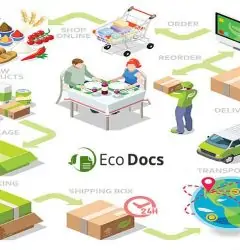14 Sep

Most food safety regulatory systems demand the establishment of documented safety control plans by food manufacturers, distributors, and operators following the concepts of hazards analysis and critical control point (HACCP). However, the difficulties of detecting possible food safety risks may be onerous to establish and manage paper-based HACCP systems.
Advanced HACCP systems that use digital technology give a more efficient and efficient method of gathering important information on food safety and provide more timely information on hygiene problems that may result in hazardous foodstuffs.
There are many programs, standards, and systems designed to ensure general food safety as well as compliance with HACCP. They typically need many additional activities and depend on tedious conventional documentation.
A digital solution for food safety, quality, and compliance with integrated task management may address those problems and be the answer to your daily job. It may assist to do the required activities in a manner that promotes the flow of your process.
What is HACCP?
HACCP is a systemic method to identifying, evaluating, and controlling food safety dangers, first established in the late 1950s to assist in guarantee food safety in the U.S. Manned Space Program.
The analysis and management of biological, chemical, and physical risks across the whole food processing/consumption cycle include the supply and handling of raw materials, through production and distribution and the consumption of the final product.
In practice, the following seven principles are established and executed through the use of HACCP systems:
- Perform a hazard analysis
- Determination of critical controls
- Set crucial boundaries
- Establish mechanisms for monitoring
- Set remedial measures
- Establish mechanisms for verification
- Establish record-keeping and processes for documentation.
Steps to Adopt a HACCP System
The acquisition and implementation of such a system is not always the easiest purchasing experience, such as selecting a new blender from the store. We wish to thus offer you an outline of the processes to adopt a digital HACCP solution, so that endless communication failures may be avoided throughout the purchase experience.
1. Before Purchase
In the first stage, it is helpful to map your particular requirements and then investigate the options that are accessible. Evaluate the supplier’s technology, price, experience, etc., and also examine their flexibility to the integration of your own devices.
2. Haggling Deal
Not all the pricing in B2B is established in a shop, therefore it’s time for bargaining. Consider the contract term, the final price, the shipping, and deployment timeline, and the required solution training. Make sure that you grill customer support or account manager for whatever you need to know.
3. Supply and Installation
You will get hardware through mail and access to the cloud software will be given, depending on what you purchased. The installation may be performed by yourself, remotely, or with a professional. But we can guarantee you that it is not rocket science!
4. Turn the System
You may now activate the system and complete all set-up chores, see automated temperature data from your new sensors in the cloud, or statistical information on new food waste monitoring procedures. After becoming familiar with the new solution, it may be time to consider extending the system to other processes and to utilize the gathered data not just for purposes of compliance, but for improvement.
5. How to Get a Seller
Selecting the appropriate vendor is the most essential stage on this trip. Just remember that you did the homework, you know what you want and it’s all about the ideal answer for you. Do your due research to set up your company, it’s worth it for the future.
Benefits OF HACCP System
Fortunately, a new influx of HACCP systems using digital technology transforms how we evaluate hygiene management programs efficacy. HACCP cloud-based platforms and software applications are now offering more flexibility in establishing and monitoring efficient hygiene procedures which minimize the risk of food contamination, for smartphones, tablets, and other portable devices. Several significant advantages and advantages offered by Digital HACCP solutions compared to conventional paper-based HACCP systems.
- Contentment — Digital HACCP systems remove paper records from the process, save paper and storage space.
- Portability and accessibility — HACCP portable applications enable data to be gathered in real-time by front-line workers. Updated information is accessible in all places instantly.
- Timeliness – Data gathered through HACCP digital systems are accessible for processing and assessment immediately.
- Advanced analytical capabilities – Cloud-based HACCP solutions offer dashboards supporting comprehensive data analysis and facilitate reporting duties.
- Knowledge transfer – Digital HACCP systems may offer instant access to instructions and further training to tackle hygiene non-compliance immediately.
- Traceability – Ultimately, digital HACCP systems guarantee the safety and traceability of the information gathered.
Conclusion
The anchoring on a single platform of all measures needed by HACCP offers numerous benefits for your business. All essential data from interactive checklists and instructions to archiving – is centrally controlled, saved, and made accessible irrespective of location. Nothing is lost and you profit from a better level of quality for your goods.
Digital HACCP systems may also assist to increase knowledge about appropriate hygiene procedures across the board when applied effectively. Employees who actively participate in data gathering get a better knowledge of the links between their activities and the effect on food safety, thus encouraging ongoing improvement efforts. Managers are better prepared with HACCP information to identify the underlying causes of ongoing issues and make the adjustments needed to solve them. The outcome is a more efficient and efficient hygiene management system to minimize the risk of infection and avoid insecure food production.




Ecodocs